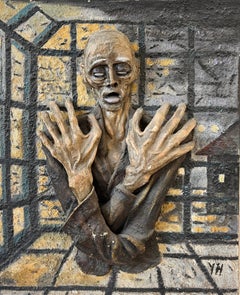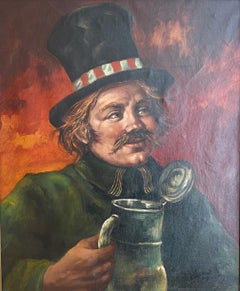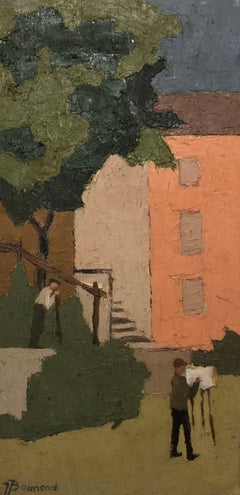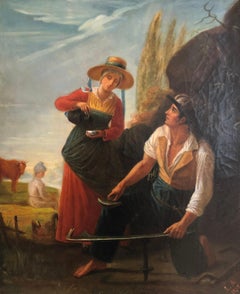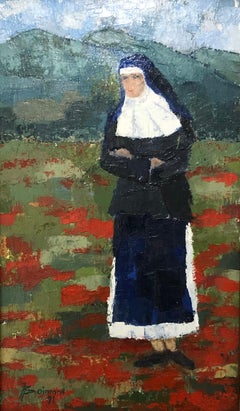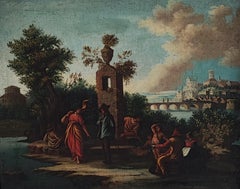Geneva - Figurative Paintings
to
19
51
50
60
15
15
Overall Width
to
Overall Height
to
7
19
159
6
3
1
8
10
12
6
1
7
2
20
7
23
14
6
5
5
4
2
1
1
105
80
6
119
67
52
44
23
23
20
13
11
8
5
5
5
5
5
5
4
4
3
3
190
168
25
25
16
6
3
115
9
22,363
19,656
Item Ships From: Geneva
The Ghost
Located in Genève, GE
Work on canvas
Technique Mixte
Monogrammed work YH
Category
20th Century Geneva - Figurative Paintings
Materials
Mixed Media, Oil
$943
The man and the mug
Located in Genève, GE
Work on canvas
Molded frame in wood and beige plaster
82 x 71 x 5 cm
Category
Mid-20th Century Geneva - Figurative Paintings
Materials
Oil
Painter and gardener at work
Located in Genève, GE
Work on canvas
Golden wooden frame
47.5 x 29 x 3 cm
Category
Mid-20th Century Geneva - Figurative Paintings
Materials
Oil
Animated characters in the countryside
Located in Genève, GE
Work on canvas
Category
1870s Geneva - Figurative Paintings
Materials
Oil
Dear none
Located in Genève, GE
Work on canvas
Golden wooden frame
48 x 29 x 3 cm
Category
1990s Geneva - Figurative Paintings
Materials
Oil
Lively landscape along the Tiber, Italy
Located in Genève, GE
Work on canvas
Golden molded wooden frame
60 x 72.5 x 5.5 cm
Category
Early 19th Century Italian School Geneva - Figurative Paintings
Materials
Oil
Autumn walk
Located in Genève, GE
Work on cardboard
Beige wooden frame
48 x 40.5 x 3.8 cm
Category
1910s Geneva - Figurative Paintings
Materials
Oil
the boulistes, a game of pétanque
Located in Genève, GE
Work on canvas
Dimensions with frame :90 x 132 x 2.5 cm
This captivating work depicts an urban scene where a group of people are gathered for a game of pétanque. The figures, seen fr...
Category
Late 20th Century Modern Geneva - Figurative Paintings
Materials
Oil
The call for recess at boarding school
Located in Genève, GE
Oil on canvas
Beige wooden frame
60 x 71 x 4 cm
Category
1950s Geneva - Figurative Paintings
Materials
Oil
M.Chat - Untitled - Street Art Signed Painting
By M. Chat
Located in Collonge Bellerive, Geneve, CH
M. CHAT
Untitled
Painting mounted on canvas
Signed
Dimensions : 120 x 120 cm including frame
Framed painting
Avec certificat
Discreet and unobtrusive, Monsieur Chat or M. Chat has been working on the streets since he was 15. His anonymity was broken in 2007 when he was caught painting his famous symbol – the cat. The man behind the mask was revealed to be Thoma Vuille, but he didn’t allow himself to be disturbed by this. Instead, he continued to exacerbate the already crystallized curiosity around the urban graphics of his increasingly present symbol. The shadow of his anonymous existence dispersed upon being shined on, but in the end, he realized that he and his alter ego are one and the same person, so he learned to drop the mask and raise his name alongside the signature of his alter ego. Believing in the idea and repeating it continuously over time, the artist got to the point where he was able to shape those around him in a way that, ultimately, the image he projects outwards is reflected back at him at times when he starts to entertain his own doubts about it.
Throughout the World
Born in Boudry, in the canton of Neuchâtel, Switzerland, Chat began roaming the streets around 1987. He studied at the Institute of visual Arts of Orléans, graduating in 2001. In 1997, during one of the workshops, the grinning cat was born. In his, now omnipresent symbol, the culture of the neighborhood meets the never-ending optimism of the artist, making a combination that is easily recognizable and widely famous. His dream of uniting human beings, different as they might be, is now possible. That single unifying subject has been found, and he’s ever since on a mission of spreading that subject throughout the world. It was this kind of contagious optimism that nudged the film-maker Chris Marker into approaching the artist, and eventually making a documentary about him in 2004. Reflecting on France’s state after the 9/11, Marker used the phenomenon of the Chat’s cat to explore the sad feelings of the people, but to share some optimism as well. The attention was not focused on the artist, for once, as we do not need to know his personal history to be able to feel something upon seeing his work. In fact, the state of mind, or an attitude, or a philosophical aspiration, is represented through an image. Behind that image lies all the simplicity of a smile painted on a wall, and all the power that comes with it. Vuille keeps the drawing simple and the line clear. On the first sight, the cat looks like a logo. However, it can’t be reduced to a logo, as it’s so much more than that. Belonging to street art, it’s a character with a strong identity and many variations. A character that achieves a symbolic dimension through its simplicity.
A Dispute with RATP – Let Art Be Free
Street art is highly unpredictable – where one sees inspirational pieces, others see the destruction of property. The artist had been previously arrested on brush in hand by the Police Municipal of Orléans in 2007. The Régie autonome des transports Parisian demanded 1,800 euros in damages, stating that Vuille had, without prior authorization, drawn inscriptions, signs or drawings, in the case of Cat Heads on the walls of the Châtelet-Les Halles station during its renovation in May 2014. Due to some contradictories, Vuille’s lawyer raised the invalidity of the notice of the artist, stating that he and his client were not completely sure what they were accused of. The court found the nullity of the summons, and the RATP finally asked one euro in damages, an amount incomparable to their previous requests. The whole thing turned out to be nothing more than a bad memory for Monsieur Chat, stating that he was not a criminal, but an artist. He also explained that his intention was to humanize a transit corridor, which was gray. All he did was putting some color on it, sharing happy feelings with all who passed nearby.
Discreet and unobtrusive, Monsieur Chat or M. Chat has been working on the streets since he was 15. His anonymity was broken in 2007 when he was caught painting his famous symbol – the cat. The man behind the mask was revealed to be Thoma Vuille, but he didn’t allow himself to be disturbed by this. Instead, he continued to exacerbate the already crystallized curiosity around the urban graphics of his increasingly present symbol. The shadow of his anonymous existence dispersed upon being shined on, but in the end, he realized that he and his alter ego are one and the same person, so he learned to drop the mask and raise his name alongside the signature of his alter ego. Believing in the idea and repeating it continuously over time, the artist got to the point where he was able to shape those around him in a way that, ultimately, the image he projects outwards is reflected back at him at times when he starts to entertain his own doubts about it.
city english cookies video
Monsieur Chat – Siesta à Paris, 2016 (Left) / Sky With Dufy, 2016 (Right), image courtesy of Galerie Brugier-Rigail
Throughout the World
Born in Boudry, in the canton of Neuchâtel, Switzerland, Chat began roaming the streets around 1987. He studied at the Institute of visual Arts of Orléans, graduating in 2001. In 1997, during one of the workshops, the grinning cat was born. In his, now omnipresent symbol, the culture of the neighborhood meets the never-ending optimism of the artist, making a combination that is easily recognizable and widely famous. His dream of uniting human beings, different as they might be, is now possible. That single unifying subject has been found, and he’s ever since on a mission of spreading that subject throughout the world. It was this kind of contagious optimism that nudged the film-maker Chris Marker into approaching the artist, and eventually making a documentary about him in 2004. Reflecting on France’s state after the 9/11, Marker used the phenomenon of the Chat’s cat to explore the sad feelings of the people, but to share some optimism as well. The attention was not focused on the artist, for once, as we do not need to know his personal history to be able to feel something upon seeing his work. In fact, the state of mind, or an attitude, or a philosophical aspiration, is represented through an image. Behind that image lies all the simplicity of a smile painted on a wall, and all the power that comes with it. Vuille keeps the drawing simple and the line clear. On the first sight, the cat looks like a logo. However, it can’t be reduced to a logo, as it’s so much more than that. Belonging to street art, it’s a character with a strong identity and many variations. A character that achieves a symbolic dimension through its simplicity.
The simplicity of the smile painted on a wall represents the state of mind
page france french
Monsieur Chat – Le Masque...
Category
21st Century and Contemporary Street Art Geneva - Figurative Paintings
Materials
Canvas
Spirale Nout
By Evelyne Ballestra
Located in Miami, FL
Her work with signs, symbols and esoteric spirituality reflects her passion for the ancient past and represents a symbolic return to the ground from which we emerged. Her work creates a commentary about “beginnings” and the transmission of signs and emotions through visual elements evoking a spiritual essence to our scientific notion of etymology. After studying 0under Rolf Dürig...
Category
21st Century and Contemporary Expressionist Geneva - Figurative Paintings
Materials
Canvas, Oil
Read More
See Kent Monkman’s Magical Realist Take on Frontier History
With a solo show at the Denver Art Museum and a commission from the Met, the Cree Canadian painter has become an international sensation.
Cecilia Vicuña Merges Politics, Science and Spirituality in Her Poetic Art
The Chilean creator, who has been living in exile in New York for decades, is having a major moment, receiving the biggest exhibitions, commissions and awards an artist could dream of.
